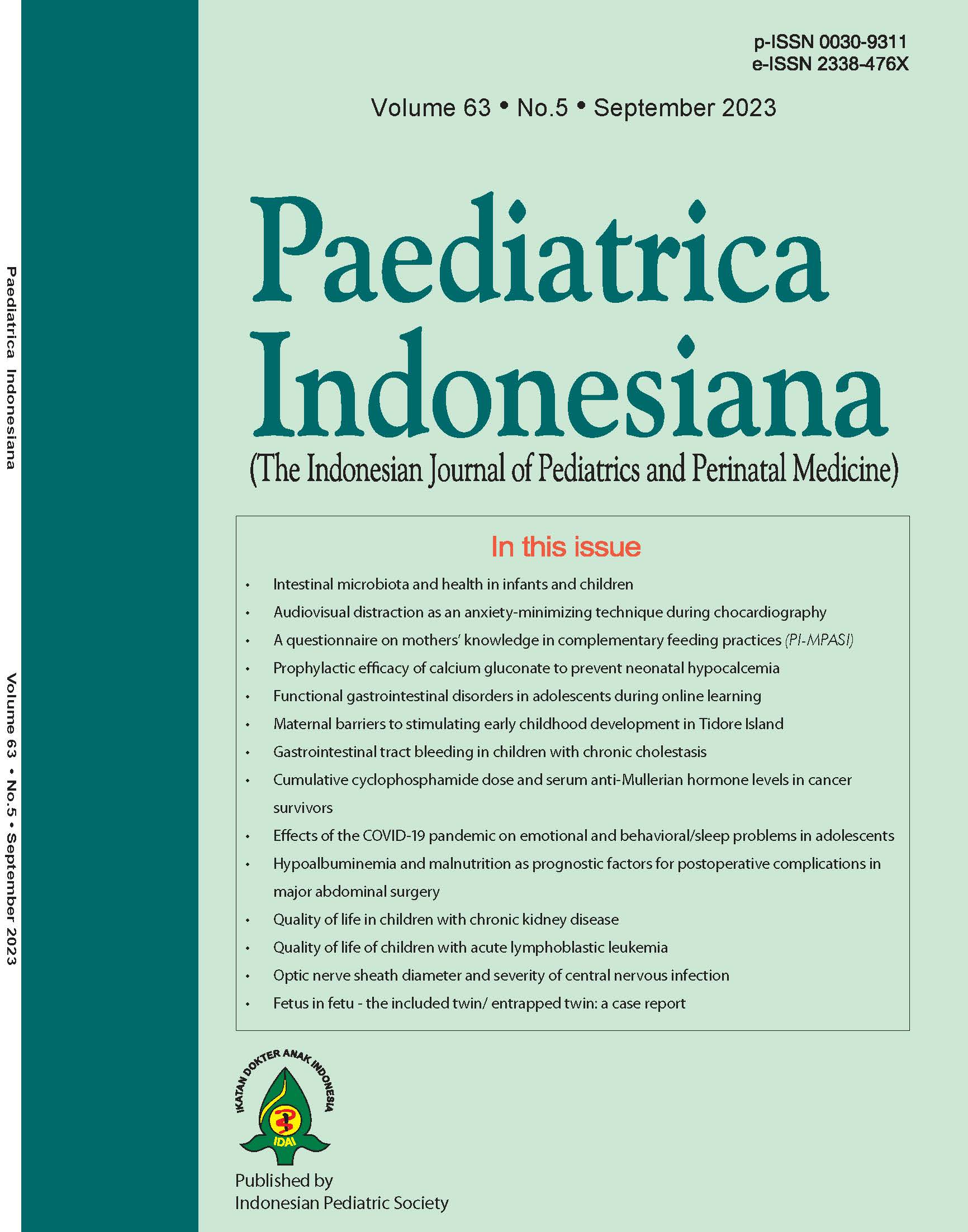Effects of the COVID-19 pandemic on emotional and behavioral problems and sleep problems in adolescents
Abstract
Background The asynchrony rapid phase of cognitive, physical and emotional development occurring in adolescence may result in various issues such as risk-taking behavior, psychosocial and emotional problems. School closure during the COVID-19 pandemic has caused a tremendous change in adolescent lifestyle and habits, including sleep patterns. causing added challenges to adolescents’ emotional and behavioral problems.
Objective To identify the association between sleep disorders with emotional and behavioral problems during the COVID-19 pandemic in urban and rural adolescents.
Methods We conducted a cross-sectional study among adolescents aged 12-18 years from November to December 2021 in two provinces, DKI Jakarta and Riau Islands. We recruited students consecutively from randomly selected junior and senior high schools. We used the Strengths and Difficulties Questionnaire (SDQ) and the Pittsburgh Sleep Quality Index (PSQI) to screen for emotional and behavioral problems and for sleep disorders, respectively. The questionnaires were sent electronically to each subject after obtaining parental consent.
Results There were 400 subjects included in our study, of which 64% were female. The prevalences of COVID-19 amongst subjects in urban and rural areas were COVID-19 12.5% and 5.5%, respectively. Emotional and behavioral disorders as well as sleep disorders were more common in rural than urban areas (13 vs. 11.5% and 50.5% vs. 38%; P=0.012, respectively). Sleep disorders were associated with the SDQ subscales of emotional symptoms [PR 4.88 (95%CI 2.97 to 8.03); P<0.01), conduct problems [PR 3.71 (95%CI 1.53 to 9.04); P=0.02), hyperactivity/inattention [PR 6.05 (95%CI 2.58 to 16.17); P<0.01], and peer relationship problems [PR 3.28 (95%CI 1.33 to 8.09); P<0.01).
Conclusion Sleep disorders among adolescents during COVID-19 pandemic were associated with emotional and behavioral problems. Adolescents who live in rural areas were more likely to have sleep disorders, emotional and behavioral problems.
References
2. Ogundele MO. Behavioural and emotional disorders in childhood: A brief overview for paediatricians. World J Clin Pediatr. 2018;7:9-26. DOI: https://doi.org/10.5409/wjcp.v7.i1.9.
3. Badan Penelitian dan Pengembangan Kesehatan Kementerian Kesehatan Republik Indonesia. Laporan Nasional Riskesdas 2018. Jakarta: Kemenkes RI; 2019.
4. Astutik W, Dewi NLMA. Mental health problems among adolescent students. Jurnal Keperawatan Indonesia. 2022;25:85-94. DOI: https://doi.org/10.7454/jki.v25i2.848.
5. Harmoniati ED, Sekartini R, Gunardi H. Intervensi sleep hygiene pada anak usia sekolah dengan gangguan tidur: Sebuah penelitian awal. Sari Pediatri. 2016;18:93-9. DOI: https://doi.org/10.14238/sp18.2.2016.93-9.
6. Hartini S, Nisa K, Herini ES. Faktor-aktor yang berhubungan dengan masalah tidur remaja selama pandemi Covid-19. Sari Pediatri. 2021;22:311-7. DOI: https://doi.org/10.14238/sp22.5.2021.311-7.
7. Windiani IGAT, Noviyani NMR, Adnyana IGANS, Murti NLSP, Soetjiningsih S. Prevalence of sleep disorders in adolescents and its relation with screen time during the COVID-19 pandemic era. Open Access Maced J Med Sci. 2021;9:297-300. DOI: https://doi.org/10.3889/oamjms.2021.5974.
8. Lewien C, Genuneit J, Meigen C, Kiess W, Poulain T. Sleep-related difficulties in healthy children and adolescents. BMC Pediatrics. 2021;21:82-93. DOI: https://doi.org/10.1186/s12887-021-02529-y.
9. Bryant A, Guy J, Calm T, Holmes J. The Strengths and Difficulties Questionnaire predicts concurrent mental health difficulties in a transdiagnostic sample of struggling learners. Front. Psychol. 2020;11:587821. DOI: https://doi.org/10.3389/fpsyg.2020.587821.
10. Manzar MD, BaHammam AS, Hameed UA, Spence DW, Pandi-Perumal SR, Moscovitch A. Dimensionality of the Pittsburgh Sleep Quality Index: a systematic review. Health Qual Life Outcomes. 2018;16:89-101. DOI: https://doi.org/10.1186/s12955-018-0915-x.
11. Dhamayanti M, Peryoga SU, Firmansyah MR. Emotional mental problems among adolescents: Urban and semi-urban settings. Althea Med J. 2018;5:77-81. DOI: https://doi.org/10.15850/amj.v5n2.1416.
12. Agha S. Mental well-being and association of the four factors coping structure model: A perspective of people living in lockdown during COVID-19. Ethics Med Public Health. 2021;16:1-7. DOI: https://doi.org/10.1016/j.jemep.2020.100605.
13. Gautam P, Dahal M, Baral K, Acharya R, Khanal S, Kasaju A, et al. Sleep quality and its correlates among adolescents of Western Nepal: A population-based study. Sleep Disord. 2021;16:1-8. DOI: https://doi.org/10.1155/2021/5590715. eCollection 2021.
14. Sampasa-Kanyinga H, Colman I, Goldfield GS, Janssen I, Wang JL, Podinic I, et.al. Combinations of physical activity, sedentary time, and sleep duration and their associations with depressive symptoms and other mental health problems in children and adolescents: a systematic review. Int J Behav Nutr Phys Act. 2020;17:72-88. DOI: https://doi.org/10.1186/s12966-020-00976-x.
Copyright (c) 2023 Bernie Endyarni Medise, Maulana Okta Reza, Yoga Devaera, Amanda Soebadi, Novie Amelia Chozie, Antonius H Pudjiadi

This work is licensed under a Creative Commons Attribution-NonCommercial-ShareAlike 4.0 International License.
Authors who publish with this journal agree to the following terms:
Authors retain copyright and grant the journal right of first publication with the work simultaneously licensed under a Creative Commons Attribution License that allows others to share the work with an acknowledgement of the work's authorship and initial publication in this journal.
Authors are able to enter into separate, additional contractual arrangements for the non-exclusive distribution of the journal's published version of the work (e.g., post it to an institutional repository or publish it in a book), with an acknowledgement of its initial publication in this journal.
Accepted 2023-10-30
Published 2023-10-30













